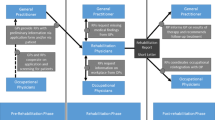Abstract
Introduction: Various obstacles to and facilitators of collaboration between an interdisciplinary work rehabilitation team and the stakeholders (workers, insurers, physicians, and employers) exist, but are not well characterized. Methods: An observational study was conducted, using videotapes of interdisciplinary team discussions of ongoing cases involving 22 workers absent from work due to musculoskeletal disorders. The actions taken and strategies adopted by the team in an effort to overcome the obstacles to collaboration were studied. Results: Various factors influence collaboration between the rehabilitation team and the stakeholders. In general, stakeholder endorsement of the team's therapeutic principles and confidence in their approach emerged as particularly important factors. Diverse strategies, most often, education and awareness-raising, were used by the team to foster collaboration among the parties. Conclusions: This study provides greater insight into the factors affecting collaboration among a rehabilitation team, an injured worker and other stakeholders. The results may improve understanding of the actions taken by rehabilitation teams and help to optimize their practices.
Similar content being viewed by others
References
Frank J, Sinclair S, Hogg-Johnson S, Shannon H, Bombardier C, Beaton D, Cole D. Preventing disability from work-related low-back pain—new evidence gives new hope—if we can just get all the players onside. Can Med Assoc J 1998; 158: 1625–1631.
Tate DG, Habeck RV, Schwartz G. Disability management: A comprehensive framework for prevention and rehabilitation in the workplace. Rehabil Lit 1986; 47: 230–235.
Anderson P. The rehabilitation and employer partnership: Walking the walk. J Vocat Rehabil 2001; 16: 105–109.
Kearns DJ. Collaborative rehabilitation at the workplace. Occup Ther Inter 1997; 4: 135–150.
Gray B. Collaborating. Finding common ground for multiparty problems. San Francisco: Jossey-Bass Publishers, 1989.
Loisel P, Durand M-J, Baril R, Langley A, Falardeau M, Décider pour faciliter le retour au travail: Étude exploratoire sur les dimensions de la prise de décision dans une équipe interdisciplinaire de réadaptation au travail. Montréal, Institut de recherche Robert-Sauvé en santé et sécurité du travail (IRSST), 2005.
Yin RK. Case study research: Design and methods. Thousand Oaks: Sage, 1994.
Glaser BG, Strauss AL. Discovery of substantive theory: A basic strategy underlying qualitative research. In: W.J. Filstead, ed. Qualitative methodology: Firsthand involvement with the social world. Chicago: Markham Publishing Company, 1972, pp. 288–304.
Miles MB, Huberman AM. Qualitative data analysis. Thousand Oaks: Sage Publications, 1994.
Loisel P, Durand M-J. Worker accommodation, clinical intervention and return to work. In: T. Sullivan and J. Frank, ed. Preventing and managing disability at work. London, ON: Taylor & Francis, 2003.
Durand M-J, Loisel P, Hong QN, Charpentier N. Helping clinicians in work disability prevention: The work disability diagnosis interview. J Occup Rehabil 2002; 12: 191–204.
Loisel P, Durand P, Abenhaim L, Gosselin L, Simard R, Turcotte J, Esdaile JM. Management of occupational back pain: The Sherbrooke model. Results of a pilot and feasibility study. Occup Environ Med 1994; 51: 597–602.
Durand M-J, Loisel P, Durand P. Therapeutic return to work: Rehabilitation in the workplace. Work 2001; 17: 57–63.
Dupuis M. La réadaptation du travailleur accidenté. Affections de l'appareil locomoteur. Québec: EDISEM, 1994.
Merrill RN, Pransky G, Hathaway J, Scott D. Illness and the workplace: A study of physicians and employers. J Fam Pract 1990; 31: 55–58.
Bernacki EJ, Tsai SP. Ten years' experience using an integrated workers' compensation management system to control workers' compensation costs. J Occup Environ Med 2003; 45: 508–516.
Rosenthal B, Mizrahi T, Strategic partnerships. How to create and maintain interorganizational collaborations and coalitions. Education Center for Community Organizing at Hunter College School of Social Work,1994.
Wimpfheimer R, Blomm M, Kramer M. Interagency collaboration. Some working principles. Adm Soc Work 1990; 14: 89–102.
Baril R, Martin J-C, Massicotte P, Lapointe C, Étude exploratoire des processus de réinsertion sociale et professionnelle des travailleurs en réadaptation. Montréal: Institut de recherche Robert-Sauvé en santé et en sécurité du travail (IRSST), 1994.
Cheadle A, Franklin G, Wolfhagen C, Savarino J, Liu PY, Salley C, Weaver M. Factors influencing the duration of work-related disability—a population-based study of Washington state workers compensation. Am J Public Health 1994; 84: 190–196.
Dasinger LK, Krause N, Deegan LJ, Brand RJ, Rudolph L. Physical workplace factors and return to work after compensated low back injury: A disability phase-specific analysis. J Occup Environ Med 2000; 42: 323–333.
Oleinick A, Gluck JV, Guire KE. Factors affecting first return to work following a compensable occupational back injury. Am J Ind Med 1996; 30: 540–555.
Benson JK. The interorganizational network as a political economy. Adm Sci Q 1975; 20: 229–249.
Loisel P, Falardeau M, Durand M-J, Baril R, Langley A, Sauvé S, Gervais J. The values underlying team decision-making in work rehabilitation for musculoskeletal disorders. Disabil Rehabil 2005; 27: 561–569.
Grilli R, Freemantle N, Minozzi S, Domenighetti G, Finer D. Mass media interventions: Effects on health services utilisation. [update in cochrane database syst rev. 2002;(1):Cd000389; pmid: 11869574]. Cochrane Database of Systematic Reviews 2000: CD000389.
Leventhal H, Brissette I, Leventhal EA. In: L. Cameron and H. Leventhal, ed. The common-sense model of self-regulation of health and illness. The self-regulation of health and illness behaviour. London, UK: Routledge, 2003. pp. 42–65.
Author information
Authors and Affiliations
Corresponding author
Rights and permissions
About this article
Cite this article
Loisel, P., Durand, MJ., Baril, R. et al. Interorganizational Collaboration in Occupational Rehabilitation: Perceptions of an Interdisciplinary Rehabilitation Team. J Occup Rehabil 15, 581–590 (2005). https://doi.org/10.1007/s10926-005-8036-x
Issue Date:
DOI: https://doi.org/10.1007/s10926-005-8036-x




